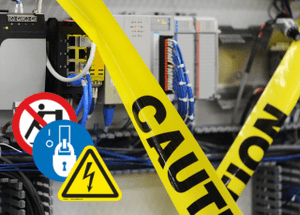The Design Process for ISO 7010 Safety Symbols

The symbols you choose to use on the ANSI Z535.4 safety labels on your products and equipment, or on the safety signs used in your workplace, are an important part of how your intended message is communicated. Standardized safety symbols are often a good place to begin when it comes to choosing a specific symbol for your application. What do we mean by ‘standardized symbols’ – and what goes into their development? Here, we breakdown the science of how symbols are created, and how it effects your labels and signs.
Standardized Symbols:
ISO 7010
ISO
7010 is an International Organization for Standardization (ISO) standard that
guides the graphical symbols that appear on safety signs, labels and tags. It’s
essentially an ongoing safety symbol collection standard where symbols that
have been standardized by ISO are housed.
The group responsible for ISO 7010 is ISO’s Technical Committee 145 (ISO/TC 145) Subcommittee 2. It’s made up of global representatives, including the United States through ANSI delegates.
When this subcommittee gathers, newly proposed symbols are reviewed and updated based on safety best practices and case law. Many different types of groups propose new symbols; requests are received from individuals, manufacturers, entire industries – and even representatives from other standards, including ISO.
National and international standards are written on 3 levels. ISO 7010 is in the most broad level, covering a wide range of industries. Because the symbols it standardizes are used by lower level standards, they must be approved in ISO 7010 in order to be recognized internationally.
After ISO/TC 145 approves symbols, they then become part of an amendment to ISO 7010. The standard itself is also periodically reviewed as a whole; for example, the latest revision took place in August 2019 and incorporated a list of recent amendments in addition to new symbols.
The Symbol Creation
Process in Detail
Creating new symbols involves review, feedback and consensus from all
delegates of ISO/TC 145 and is a lengthy and thorough procedure. The process
includes the following steps:
- A new item is proposed.
- ISO/TC 145 assess the request to decide if the new or modified symbol is necessary to deliberate on. If enough countries support it, the symbol passes on to the next phase.
- A committee draft (CD) gets circulated for comment and comments are reviewed.
- A new CD or draft information standard (DIS) is created and again is circulated for comments and review.
- Eventually, a final draft information standard (FDIS) is circulated for vote. During this process a consensus must be reached.
- Finally, the symbol is published through an amendment to the standard.
What This Means for
Your Labels and Signs
Laying out the process of how symbols are created can help to show why it
is crucial to rely on standardized symbols – or ones created with ISO design
principles. It comes down to better protecting people from harm when using your
equipment or products, or going about their job in your workplace.
“Essentially, ISO 7010 is a living, breathing document. It’s intended to be revised regularly – and to be relevant for today’s manufacturers and for whole industries. An intelligent, thought-filled process goes into creating these symbols, to ensure better safety for us all,” says Angela Lambert, our Director of Standards Compliance at Clarion Safety and a delegate representative to ANSI for ISO/TC 145.
Using Best
Practices for Your Labels, Signs and Symbols
In the past decade, there’s been a growing movement both in the U.S. and
internationally to use graphical symbols to convey safety information. Including
symbols on your safety labels and signs has many advantages that can help bring
a higher degree of effectiveness to your warnings. The specific symbols you use
– as well as the overall content of your warnings – can be complex, with many
decisions to make. Remember that Clarion Safety is here to help. Our customer
service team is
trained in
the ANSI and ISO standards, using a proprietary education curriculum that
we call “Clarion Essentials”; it means that they can guide you in applying the
latest best practices effectively. We can help you create
custom labels,
signs or tags – or even, if needed, a custom
symbol based on standards-based design rules. Get in touch with our team
and let us know how we can help strengthen your visual safety communication.



